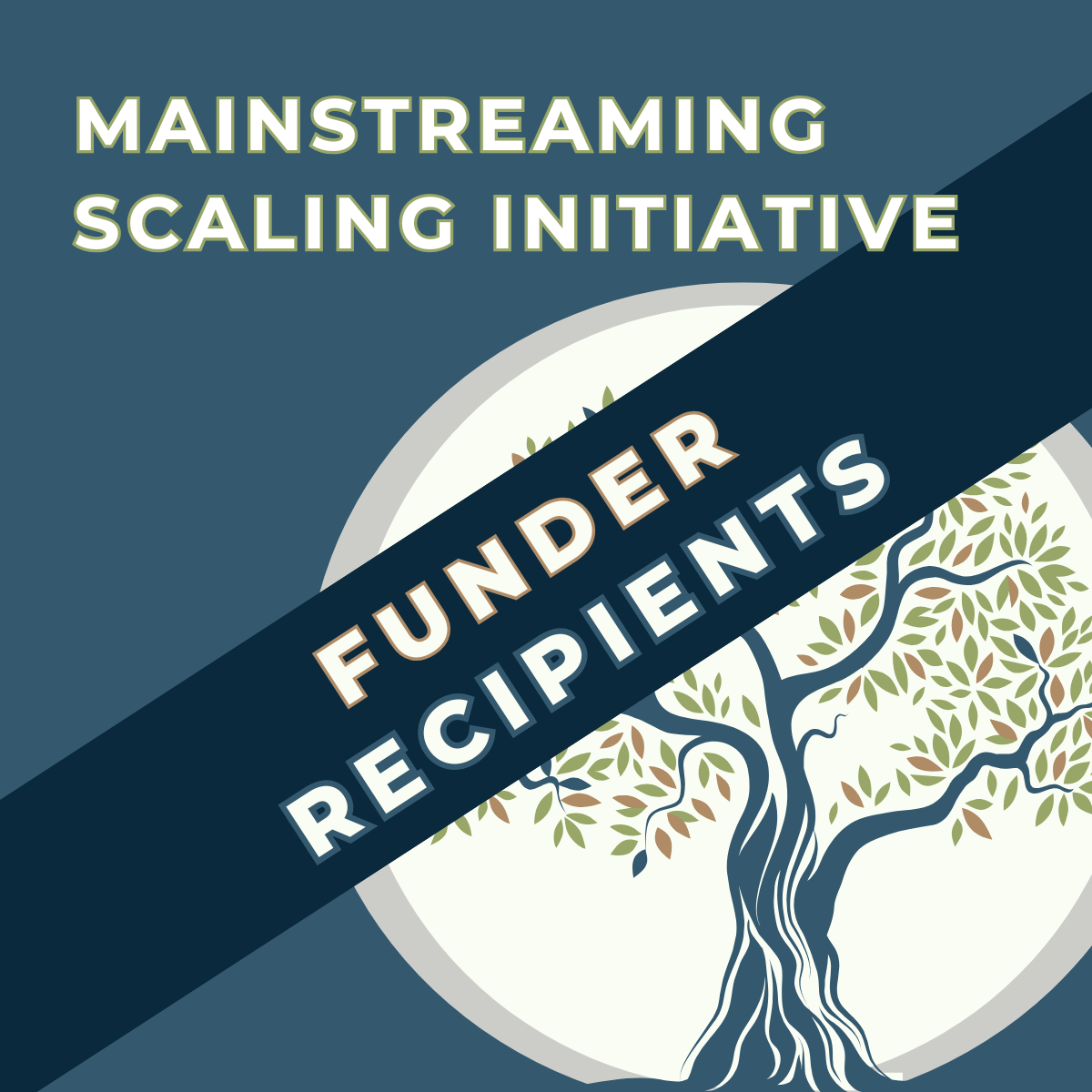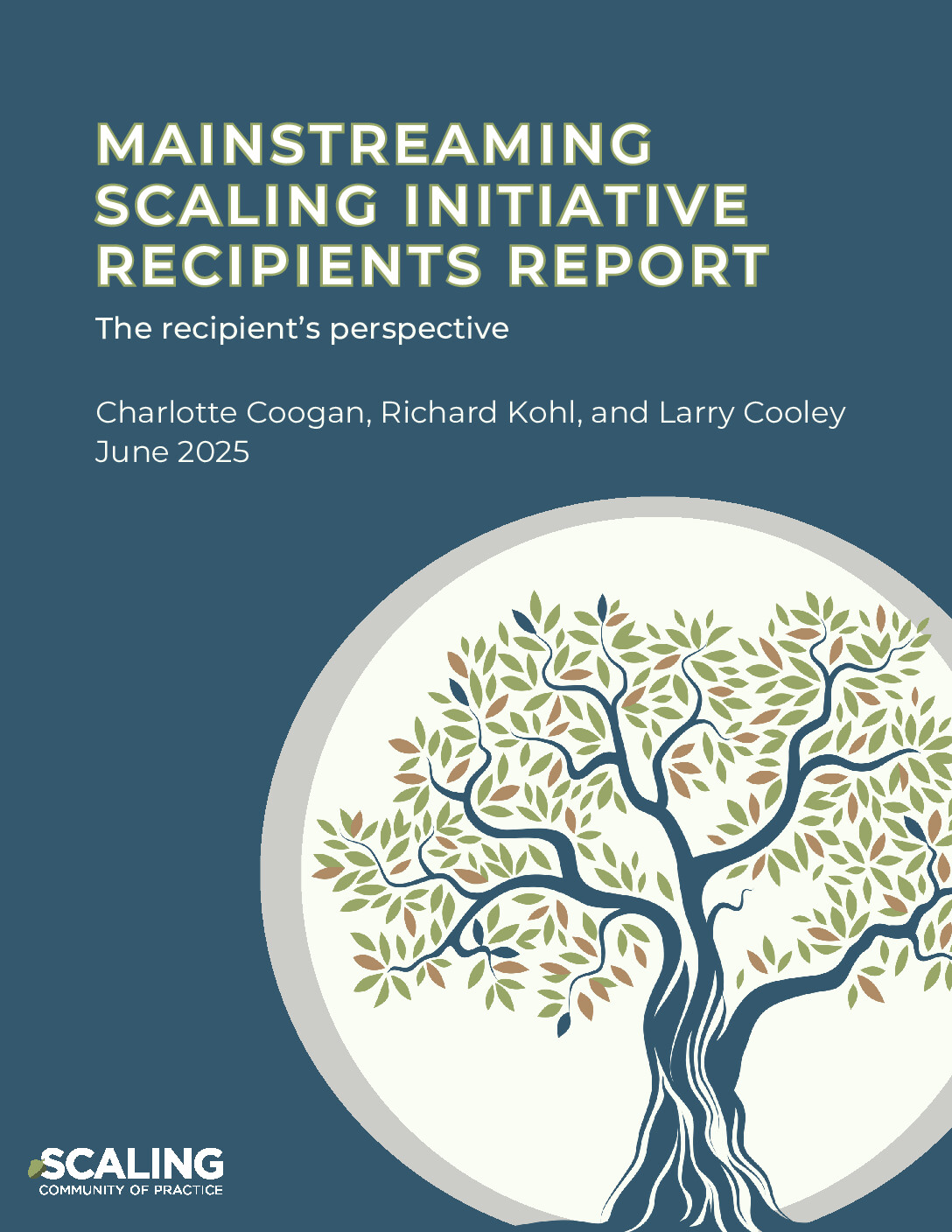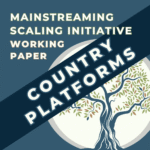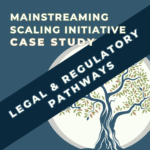Abstract
Funder practices significantly shape the ability of recipients—primarily implementing organizations in the Global South—to achieve sustainable outcomes at scale. This report examines recipients’ perspectives on how funders’ actions and requirements affect their capacity to scale development interventions effectively and sustainably. Drawing on key informant interviews, written stories, and a focus group, this report provides insight into recurring challenges and identifies actionable opportunities to improve funder-recipient dynamics.
The report finds that, according to recipients, funders vary widely in their understanding and support for scaling. Recipients often lack the longer-term, flexible, and adaptive funding necessary to scale. Proposal processes are cumbersome and often misaligned with scaling goals, emphasizing compliance and immediate outputs over the adaptive learning and flexible approaches necessary for sustainable impact. Reporting frameworks are largely focused on short-term metrics rather than iterative progress, limiting their utility in scaling efforts. However, monitoring and evaluation provide opportunities for adaptive program management, if flexibility is allowed. Relationships with funders emerge as a central factor, with trust-based, collaborative engagements enabling more effective scaling. Foundations, while providing greater flexibility and relational support, typically offer smaller grants that limit their overall impact.
For recipients, funders’ roles extend beyond financial support. Leveraging networks to foster partnerships, enabling local governments, and co-creating adaptable solutions are critical to achieving transformative scaling. The report concludes with recommendations for funders to adopt flexible, long-term funding strategies; realign monitoring and evaluation frameworks to support scaling processes; and strengthen relational trust and collaboration with recipients. These shifts are essential to better support recipients in achieving sustainable impact at scale.
CLICK HERE TO READ MORE
Introduction
In 2023, the Scaling Community of Practice initiated a three-year collaborative, action-research project on mainstreaming systematic approaches to scaling in funder organizations. To date, the Mainstreaming Initiative focused on the experience of mainstreaming systematic and consistent approaches to scaling within funder organizations. It assembled thirteen case studies and drew conclusions in an interim synthesis paper and policy brief. Additional case studies are currently under preparation and a final report with findings and lessons is expected to be issued in the summer of 2025.
Missing from the initial case studies and cross-cutting analysis was a deliberate effort to incorporate the perspectives of funding “recipients.” Funding recipients play a vital role in scaling development interventions because they are commonly the “doers” of the scaling work. However, they face distinct challenges in obtaining third-party funding and navigating relationships with funders. Although issues such as fairness, sustainability, and localization have been prominent in the discourse on international development funding over the past decade and more, discussions remain dominated by Global North perspectives. To address this imbalance, we collected commentary about experiences with funders from organizations based in the Global South – public, private, or civil society – that have pursued or secured third-party funding for scaling development interventions. Due to time and resource limitations, the number of organizations queried was relatively small. We nevertheless hope that this survey provides a useful first step in exploring the issue and contributing to the larger scaling and localization agendas.
Although the literature on this topic remains thin, we available publications are presented in Appendix 1. These efforts, while laudable, provide narrow insights into the experiences of recipients. They are limited to certain funders or certain types of funders and recipients. Their findings are broadly consistent with findings of our current study. Additional efforts to gather and synthesize a range of recipient perspectives could enhance the international discourse and promote a funding environment that supports the needs of diverse recipients working toward sustainable change at scale.
Methods
Results are based on views expressed in 10 key informant interviews, 8 written stories, and an online focus group (Appendix 2). There was some overlap in participants, with a few people attending the online focus group and also participating in the interviews or providing written stories.
Key informant interviews
Participants were identified through referrals from the professional network of the Scaling Community of Practice and selected based on their unique, and often successful, experiences with scaling. Of the 10 key informant interviews conducted between September and November 2024, eight were from implementing organizations, and two were recipient “advocates” – people from the Global North championing implementing organizations in the Global South. Participants were mostly from South Asia and Sub-Saharan Africa. They worked in health, entrepreneurship, youth, and research.
Interviews were based on a common protocol. They focused on participants’ engagements with funders, both seeking funding and implementing projects once they had been funded. Conversations evolved organically to explore specific examples, successful strategies, and challenges that prevented recipients from contributing to sustainable outcomes at scale. Particular emphasis was placed on understanding interpersonal dynamics, positive experiences, and success stories. Respondents were also invited to comment on blind spots or omissions they observed in the interview to reduce bias from the interviewer’s own experiences and perceptions.
Written stories
A public call was sent out to the Scaling Community of Practice’s 4,200+ members inviting them to submit written stories about their experiences seeking and implementing funding for scaling. Eight members submitted written stories providing detail on their organization, their scaling work, and their experience in securing or implementing funding for scaling. Participants who submitted stories were from Africa and the Caribbean, with many operating across several countries. Organizations represented in the written stories were often early in their scaling journey, seeking opportunities to expand their work.
Online focus group discussion
Scaling Community of Practice members were also invited to participate in an online focus group discussion about their experiences seeking and implementing funding for scaling. The event, designed as an interactive, Mentimeter-based session, collected information about how recipients engaged with funders, what they thought was going well, and what specific challenges they faced. Participant input was both quantitative, asking participants to provide rankings and ratings, and qualitative, inviting them to share short stories or create a word cloud. Results from each poll were briefly shared with participants throughout the session to maintain interest.
The 30 participants were from Sub-Saharan Africa, Latin America and the Caribbean, and Southeast and East Asia. Participants had had experience with 18 official funders and foundations.
Qualitative data coding and analysis
The transcription tool in Microsoft Teams was used to transcribe the key informant interviews. Interviews and member stories were uploaded into Dedoose a qualitative coding software. Coding and analysis were conducted in phases through an iterative reading, coding, and summarizing process.
Results
Seven themes were found in how recipients engage with funders:
- Funders differ widely in how they define scaling.
- Recipients lack the longer-term, flexible, adaptive funding needed to implement scaling strategies.
- The proposal process is cumbersome and not focused on scaling.
- Funder reporting requirements and M&E approaches are not attuned to scaling.
- Relationships play a central role in funder-recipient interactions.
- Foundations do somewhat better than other funder organizations.
- Funders can provide more than money.
1. Funders differ widely in how they define scaling
One of the most important findings to emerge from Phase I of the Mainstreaming Initiative was the distinction between transactional and transformational scaling. The goal of scaling is not simply to expand interventions (transactional scaling) but to transform systems for sustainable impact (transformational scaling).
When asked to score their funders’ approach to scaling along a continuum from transactional to transformational, focus group participants rated funders as falling into three groups: a two are fully transactional, several fall in the middle, and a group are at the other extreme, transformational (Figure 1). Most recipients rated their own definitions relatively similarly.

Note: Participants were asked to rate themselves and funders on a scale of 1 to 10.
2. Recipients lack the longer-term, flexible, adaptive funding approaches needed to implement scaling strategies
Recipients lack the dedicated, long-term, flexible funding necessary to scale. Focus group discussion participants and a few key informants indicated that the lack of dedicated funding for scaling can pose a barrier. The focus group discussion and a few interviews revealed that short-term, project-based funding often forces recipients to prioritize immediate outputs and quantifiable metrics at the expense of iterative testing, phased planning, and adaptive learning (see Result 4). The preference for funder-defined activities restricts recipients’ abilities to adjust programs based on real-time feedback or evolving needs. Focus group participants rated the inability to pivot as their largest implementation challenge (Figure 2).

Note: Participants were asked to allocate 100 “points” across these pre-specified challenges in implementing funding for scale.
Caps on overhead and a lack of core funding hinder the abilities of smaller organizations to build and sustain the capabilities needed to meet compliance and due diligence requirements (see Result 4). According to the single private sector participant in the interviews, limited overhead and restrictive funding structures are particularly problematic for the private sector, which has an obligation to make a profit. The private sector participant noted that this contradicts the growing prioritization of private enterprise in the funding source. Once project funding concludes, recipients frequently struggle to maintain or expand their work due to a lack of continued support, with several interview participants expressing concern about the future of their organizations and staff after large grants end.
In contrast, flexible funding models enable co-creation, iterative learning, and problem-solving, allowing organizations to engage consistently with local stakeholders and build the trust—especially with governments—necessary for scaling (Figure 3). Stable, long-term funding helps organizations lay the groundwork for sustainable growth and ensures they can adapt to complex scaling demands while maintaining the capacity to foster critical relationships over time.
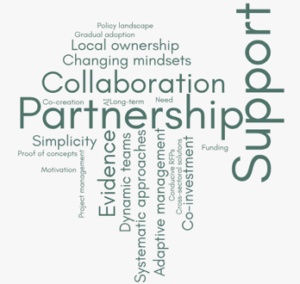
Note: Participants were asked to list separately what is going well in securing and implementing funding for scale, but concepts were generally crosscutting and are presented together here. For presentational purposes, conceptually similar words were combined to create a more informative word cloud. The size of the word in the cloud reflects the frequency of use in the responses.
3. The proposal process is cumbersome and not focused on scaling
Respondents noted that challenges with the type of funding that is available start with the proposal process. The proposal process can determine what is scaled, with co-creation being an important component of effective design for scale. Focus group discussion and interview participants highlighted a preference among funders for high-profile, showy innovations over incremental but transformative progress. This approach, referred to by interview participants as an “RFP-based approach to financing,” limits recipients’ abilities to co-create or adapt initiatives relevant to local context (see Result 2). Rigid structures imposed by funders during the proposal phase become particularly problematic in implementation when engaging with local governments, which have their own agendas and budgetary constraints. Local governments are less likely to participate in activities that fail to align with their goals. One interview participant noted that official development donors, due to their political mandates, may be better positioned than foundations to co-create projects with local governments, partially alleviating this issue.
While restrictive and predefined calls for proposals are common, a few participants mentioned appreciation for flexible calls that allow significant latitude to tailor activities to local contexts. Flexible approaches allow for alignment with on-the-ground realities and increase the likelihood of scaling success. In contrast, overly prescriptive or misaligned calls for proposals led some participants to decline funding opportunities altogether. Efforts to align funder and recipient priorities during proposal development have seen mixed outcomes, with participants reporting varying degrees of success and frustration.
According to interview participants, funders tend to prioritize established, well-resourced organizations—often based in the Global North—due to their perceived lower risk, leaving smaller and local organizations at a disadvantage. Interview participants and member stories elaborated that small and medium sized implementing organizations may not have the resources to support extensive business development operations and due diligence processes, making them uncompetitive for the large grants associated with scaling. Several recipients mentioned withdrawing applications because of excessive due diligence processes, noting that this decision was rooted in a belief that these requirements signalled funders’ distrust and a lack of flexibility.
4. Funder reporting requirements and M&E approaches are not attuned to scaling
Required reporting, a regularly mandated part of communication, was almost universally mentioned by interview participants, often negatively. Compliance and reporting were also rated as significant challenges by focus group discussion participants (Figure 2). Comments in interviews focused on how onerous reporting requirements are, demoralizing staff and taking them away from programming work. Because compliance and reporting requirements often take-up larger proportions of budgets within smaller projects, these constraints are particularly severe for smaller organizations. Excessive reporting and requests for revisions can be perceived as offensive when they are interpreted to (or actually do) reflect a lack of trust, are seen as disproportionate to the size of the project, or both. Reporting requirements can be particularly onerous when recipients are sub-contractors working with a prime contractor because they receive layered requirements from the funder and the prime. However, some respondents noted that face-to-face meetings that occur alongside required reporting provide an opportunity to plant the seeds for future iterations of their projects. Such meetings can also be used to start conversations about joint problem solving when milestones are not met.
Monitoring and evaluation (M&E) emerged as a critical tool for flexible, iterative scaling. Recipients observed that scaling is an iterative process that requires trial and error, learning from each phase, and adapting strategies based on ongoing assessments. Several interview participants and member stories highlighted how M&E activities, when designed to go beyond basic reporting requirements, can create opportunities for re-design, co-learning, and adaptive management. M&E can create breakthrough moments in programming and funder engagement, allowing for program re-design and co-learning and making a compelling case for program expansion or extension. This exploratory M&E is distinct from the reporting typically required by funders, which focuses on numerical outputs that can overlook the soft outcomes and systems change essential to scaling, especially in the first few years. Interview participants noted that outcomes often take years to develop and causal attribution can be challenging. Being evidence based and using adaptive management were listed as positive aspects of programming by focus group participants (Figure 3).
Some interviewees noted that the real-world learning and experiential evidence traditionally generated by Global South recipients was undervalued by funders relative to external, academic evidence traditionally generated by Global North organizations. Interviewees also expressed the view that the value of direct conversations with beneficiaries and other stakeholders, sometimes framed as “clients”, is undervalued by funders.
5. Relationships play a central role in funder-recipient interactions
According to interview participants and member stories, funder-recipient relationships form the backbone of the process through which funding is secured and implemented for scale. They are the stage upon which program agendas, flexibility, compliance, and M&E perform. Egalitarian and collaborative relationships support scaling by allowing for trust, iteration, and joint problem solving. According to interview participants, a key component of egalitarian and collaborative relationships is for funders to understand that the recipients are the experts in the field. This does not require that funders consistently defer to recipients, but it means that funders are open minded and adopt a learning lens.
Most recipients interviewed had at least one specific story about a funder that placed trust in them, allowed them to adapt their program, and, thereby, catapulted the initiative to a new phase or scale. In a few cases, funders explicitly encouraged their recipients to scale. Several member stories also reflected an appreciation for this supportive, respectful, and collaborative environment.
Several interview participants mentioned the importance of honest and transparent communication with funders about challenges and failures. Change, failure, and the need for modification are inevitable in large, iterative, scaling projects. Recipient initiated surveys, monitoring, and evaluation can provide a valuable learning experience and opportunity for re-design if the funder is sufficiently receptive and trusting to allow for such evolution (see Result 4). To proactively track this process and manage communications, one participant used a change log, which regularly updated their funder on project modifications and provided justifications for these changes. Transparency can be celebrated and probed through joint learning and collaborative inquiry when funders choose to take an egalitarian approach to their relationship with recipients.
Hierarchical, donor driven structures prevent iteration and can result in projects that do not respond to local context. A few interview participants mentioned specific examples of hierarchical relationships where funders dictated programming without listening to their recipients. These programs were perceived to be impractical and sometimes abandoned by the implementers.
Interview participants and member stories showed that recipients invest significantly into their relationships with funders. Recipients often put years of efforts into educating their funders and co-creating activities. They endeavour to build stable relationships with funders, and it is these stable relationships that lead to the scaling of projects beyond grants. However, recipients note that this puts a premium on their having the financial wherewithal to support such long-term investment in funders, which often goes unpaid.
6. Foundations do somewhat better than other funders
Key informant interviews and focus group discussions indicated that foundations are more likely than official funders to provide flexible funding, but their grants tend to be smaller (Figure 4). Foundations are notable for their flexibility and willingness to foster collaborative relationships, which build trust between funders and recipients. They tend to engage more in co-creation, learning, and joint problem solving, and are often perceived as more respectful. However, one participant noted that this flexibility is more characteristic of family foundations, as corporate foundations often treat recipients more like contractors.

Note: The question asked was “Who is most likely to fund scaling?”.
7. Funders can provide more than money
Interview participants encouraged funders to reflect on what they can do for their recipients other than provide funding. They suggested that engaged funders can have a transformative effect on the partnerships that are developed by organizations that wish to scale and to be effective agents of scale. Focus group participants listed support for partnerships, collaboration, and co-investment as key traits of scaling implementation that work well (Figure 3). Direct funding for partnership and handover was also mentioned by some interview participants.
According to interview participants and a participant story, funders can help their recipients develop relationships and partnerships with external organizations, often by making greater use of their convening power. These relationships and partnerships can support the joint implementation of projects, allow groups to expand their programming, improve cross-organizational learning, and help recipients access funds from other donors. While financial support for these partnerships would be appreciated, that was not the dominant request to funders.
Several noted that facilitating partnerships among grantees is a potentially low-cost way to support partnerships. One recipient advocate discussed developing learning hubs between grantees and financially supporting them to develop joint learning outputs. An interview participant noted that simply having the funder signal support for collaboration between grantees could be an important catalyst as recipients may not immediately respond to requests from one another.
Recipients noted that funders can often dictate how governmental partnerships operate, thereby determining their success. They also observed that, when country governments become an additional set of stakeholders in programming, they need to be approached as equals in design and implementation decision-making. This can become problematic, they noted, when funders design RFPs and decide upon recipients without including country governments. Foundations were seen as more likely than official donors to design RFPs in this manner. Similarly, recipients who are not given the flexibility to respond to changing governmental priorities and needs say that this often limits their ability to implement their projects and pursue sustainable scaling. They also emphasized that stable funding, space for co-creation, and flexibility to respond to changing agendas is particularly relevant to working with governments for scale (see Result 2).
Recommendations directly from recipients
Focus group discussion member overwhelmingly recommended that funders listen more to the insights of implementers regarding the real-world challenges experienced and the direction the program should take (Table 1). These recommendations broadly align with those coming from the interviews; although, interviews highlighted recommendations for more flexible and stable funding more than focus group discussion participants.
Table 1: Recommendations made by focus group participants.
| Recommendation | # of votes |
| Listen to the insights of the people who are on the ground to understand the opportunities and the challenges and the direction the program should take. | 7 |
| Allow flexibility in timelines Support capacity building of government and local actors Provide separate funds for building partnerships |
3 |
| Scaling takes time and needs to be assessed in incremental changes that show alignment with the broader scaling strategy. | 2 |
| Create standards and procedures for measuring scalability, monitoring progress, and adaptive management. | 2 |
| View investment as impactful only if they scale and benefit a large population. To achieve this, the scaling-up process must be integrated from the very beginning. | 2 |
| Adopt systemic approaches (micro, meso, macro) Involve public AND private sector stakeholders Build capacities of public AND private service providers Integrate services into portfolios |
2 |
| Take the context of the implementation location into consideration. | 2 |
Note: Focus group discussion participants were invited to make recommendations to funders and then offered the opportunity to vote on the recommendations made by others. Only recommendations that received more than two votes are presented.
Conclusions
Recipient representatives consulted for this study, while appreciating the financial support they receive from funders, raised concerns about funders’ inadequate focus on the scaling needs of recipients, including that:
- The proposal process is cumbersome and not focused on scaling.
- Funders’ agendas, reporting and compliance requirements often impede sustainable scaling.
- Recipients lack the longer-term flexible funding needed to implement scaling strategies.
- Funders often have monitoring and evaluation timeframes and approaches not attuned to scaling.
- Funders do not invest enough in the longer-term relationship, capacity building, and listening aspects of their partnership with recipients.
Looking ahead, we conclude that funders should focus on the following aspects to support effectively the scaling efforts of their recipients:
- Long-term funding to support the development of stable, trust-based relationships. Such funding provides room for iteration, alignment with local agendas, and sustainable handover of projects.
- Flexible funding to allow for testing, piloting, and program re-design in response to evolving needs and monitoring and evaluation evidence.
- Leveraging long-term, flexible funding to facilitate trusting and collaborative funder-recipient relationships, characterized by effective communication, iterative learning, co-creation, adaptation and program re-design in response to evolving needs and monitoring and evaluation evidence.
- Using these relationships to facilitate the development of partnerships to ensure projects are aligned with local agendas and achieve a sustainable handover for successful, sustainable, and transformative scaling.
- Evaluating funder activities to appropriately focus on the scaling in a way that encompasses the perspective of recipients.
Appendix 1: Authors’ experience and literature review
In this appendix we briefly summarize the experience of the authors and the very limited evidence from the literature that we consulted. It is broadly consistent with the findings of our study.
Based on the authors’ own first-hand experience, recipients often struggle with compliance and reporting requirements imposed by funders, which limit their ability to pivot and use adaptive management techniques. Project-based, inconsistent funding can make it challenging for organizations to hire and retain staff, build capacity, and prepare for sustained scaling. This lack of capacity is sometimes used to justify why local organizations are unsuitable partners. Local organizations, including governments, may become so invested in the projects they already support that they cannot make additional investments to scale, even for one-time costs, let alone the ongoing expenses associated with delivering at scale. However, these are just our perspectives; more Global North voices entering the discourse.
Some recipients have begun to voice reflections on funder-recipient dynamics. Leaders of Last Mile Health and Educate Girls, shared their experiences as recipients of “big bet” philanthropy. They appreciated these major investments but reported challenges once the funding ended, particularly due to the lack of transition support from philanthropic funding to local government ownership. Suggested solutions to address this funding cliff include donor commitment strategies, coordinated fundraising efforts, and empowering recipients to make decisions in their best interests. However, these discussions were confined to the big bet philanthropy.
The International Development Research Center (IDRC) took steps to interrogate their own effects on their grantees, empowering their grantees to propose funder actions that support scaling by Global South organizations. The ScalingXChange identified eight core recommendations for funders:
- Keep your focus on scaling impact
- Broaden your understanding of participatory approaches
- Make equity of impact an equal measure to magnitude of impact
- Address the environment as a prat of the scaling system
- Move beyond a ‘project logic’ to fund impact
- Simply scaling ‘what works’ doesn’t work, support a learning culture instead
- Support Southern solutions
- Invest in the science of scaling
Following this effort, IDRC published an evaluation of its scaling strategy to reflect on its implementation of these recommendations. However, these insights are specific to IDRC, an organization notably committed to supporting its grantees.
SPRING Impact’s recent study on nonprofits’ experiences in securing funding provided further insights into these challenges. They find that philanthropic funding is often limited, with foundations expecting grantees to find alternative sources of funding even as non-profits continue to require ongoing philanthropic support. In particular, non-profits require unrestricted, long-term funding, which may be more common from philanthropies. They also need targeted funding for the support they provide partners, particularly governments, in implementing projects at scale. Because of the limiting funding that is available, non-profits prioritize cost effectiveness.
When reviewing the mainstreaming of scaling within the Global Financing Facility, the Scaling Community of Practice collected perspectives from three recipient countries. Recipients discussed funding challenges such as fragmentation in international health financing; misalignment of goals between stakeholders; and uncoordinated technical assistance, monitoring, and evaluation. The Global Financing Facility’s efforts to mitigate these issues through coordination and recipient inclusion were acknowledged, but detailed feedback from recipients on their perceptions of the facility itself was not provided.
Recent portfolio reviews by the Adaptation Fund and IFAD came close to examining the recipient perspective of their funding, but fell short. The Adaptation Fund reflected on its grant making process, but did not actually ask how this process was perceived by or affected its grantees. IFAD conducted a review of the support it provides to scaling, but focused on the IFAD’s perceptions of its processes as well as the effectiveness of supported projects and challenges encountered.
These efforts, while laudable, provide narrow insights into the experiences of recipients. They are limited to certain funders, or certain types of funders. Additional efforts to gather and synthesize the perspectives of a range of recipients has the potential to strengthen the international discourse by supporting a funding environment that addresses the needs of a range of recipients in their efforts to make sustainable change at scale.
Appendix 2: Participants
All participants were promised anonymity in exchange for their participation. Many provided valuable and unvarnished truths about their experiences, which they may not be prepared to share publicly. Therefore, the descriptions of participants provided here provide some context for interpreting these findings.
Table A1: Participants in key informant interviews.
| Number | |
| Total interviews | 10 |
| Implementers | 8 |
| Private sector | 1 |
| Intermediary organizations1 | 4 |
| Advisors2 | 6 |
| Experience working with governments | 9 |
| Originally from the Global North | 3 |
| Female | 5 |
| Sector | |
| Health | 3 |
| Entrepreneurship | 3 |
| Youth | 2 |
| Research | 2 |
| Region | |
| International3 | 2 |
| South Asia | 5 |
| Sub-Saharan Africa | 3 |
Notes:
- Intermediary organizations are defined as those who serve as a pass through for funding or are coordinating and knowledge aggregation platforms for smaller organizations.
- Advisors are individuals or organizations whose mandates include a significant amount of technical assistance for community based organizations, local NGOs, or governments.
- International organizations excludes representatives of national arms of international organizations.
Table A2: Story submissions.
| Number | |
| Total submissions | 8 |
| Implementers | 8 |
| Intermediary organizations1 | 0 |
| Advisors2 | 5 |
| Private sector | 0 |
| Experience working with governments | 8 |
| Sector | |
| Climate, environment, agriculture | 4 |
| Entrepreneurship | 1 |
| Youth | 1 |
| Research | 1 |
| Education | 1 |
| Region and reach | |
| Multinational3 | 6 |
| Latin America and Caribbean | 2 |
| Sub-Saharan Africa | 6 |
Notes:
- Intermediary organizations are defined as those who serve as a pass through for funding or are coordinating and knowledge aggregation platforms for smaller organizations.
- Advisors are individuals or organizations whose mandates include a significant amount of technical assistance for community based organizations, local NGOs, or governments.
- Multinational organizations work in several countries. They are also counted in the specific regions based on where they work.
Table A3: FDG participants.
| Number | |
| Estimated number1 | 30 |
| Type of organization | |
| Participants responding | 17 |
| Local NGO | 4 |
| International NGO | 5 |
| Research group | 3 |
| Private sector | 2 |
| Local government | 1 |
| Other | 2 |
| Experience with funders2 | |
| Participants responding | 15 |
| Foundations | 7 |
| Official funders | 8 |
| Research funders | 3 |
| Region | |
| Participants responding | 16 |
| Europe | 3 |
| Latin America and Caribbean | 2 |
| Sub-Saharan Africa | 6 |
| South Asia | 3 |
| East Asia | 2 |
Notes:
- Names of participants were not recorded and because some logged in and out throughout the session, the exact number cannot be confirmed. In addition, only about half of participants responded to each question.
- Some participants worked with more than one funder type.
